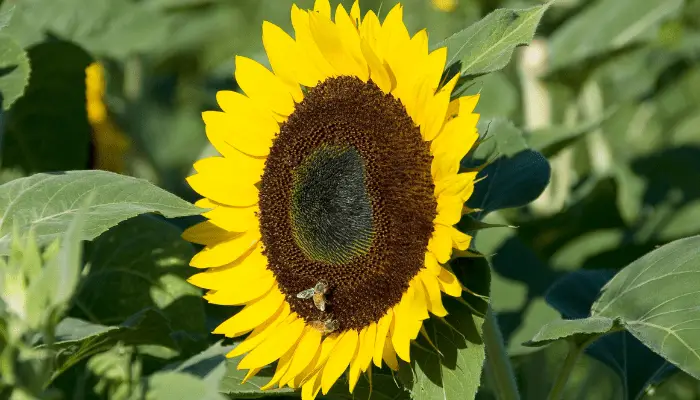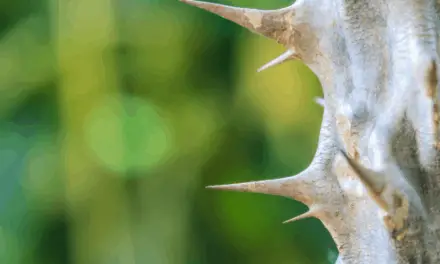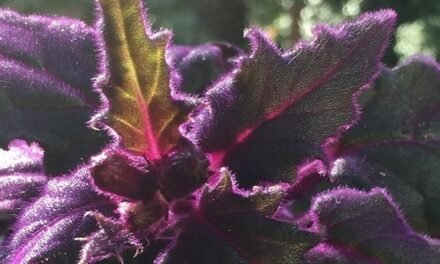Wind-pollinated flowers are different from insect-pollinated flowers because they produce smaller and lighter pollen grains that weigh less and can be easily carried by the wind. Insect-pollinated flowers produce larger pollen grains that are sticky and spiny so that insects can more easily transport them between flowers.
Table of Contents
What Is Pollination?

Pollination refers to the process of pollen grains being transferred from the male anther of one flower to the female stigma of another.
The goal of all life on earth, including flowers, is to reproduce and ensure the survival of the next generation and one of the ways in which flowers can produce offspring is through making seeds.
There are different agents of flower pollination but in this article, we will be focusing on two:
- Wind Pollination.
- Insect Pollination.
In this guide, you’ll learn how to differentiate between wind and insect-pollinated flowers.
One of the biggest differences between wind-pollinated flowers and insect-pollinated flowers is that insects are only attracted to insect-pollinated flowers and not to wind-pollinated flowers.
But there are many differences between both these categories of flowers so let’s take a look at a few of them.
The Differences Between Wind-Pollinated Flowers And Insect-Pollinated Flowers?
Wind-pollinated flowers are different from insect-pollinated flowers in a number of different ways.
Related Article: What Is Causing Bumps In My Lawn And How Do I Fix It?
Different Methods Of Pollination
Wind-pollinated flowers are pollinated by wind, while insects pollinate insect-pollinated flowers.
You wouldn’t likely see an insect (like a honey bee) perching on a wind-pollinated flower and likewise, you wouldn’t see situations where the wind would be pollinating an insect-pollinated flower.
Through the wonder of nature, these flowers have evolved to reproduce in very different ways.
Scent And Nectar
Wind-pollinated flowers are devoid of any scent or nectar.
On the contrary, insect-pollinated flowers grow with scents and nectar.
Insects need to be attracted to flowers for them to be part of the pollination process.
And insects are quickly attracted by the nectar and scent these insect-pollinated flowers produce.
In other words, if a flower does not contain any nectar or has any scent, the chances of an insect pollinating that flower will be practically zero.
Differences Of Pollen Grains
The pollen grains of wind-pollinated flowers are generally light so that the wind can easily carry them.
But the pollen grains of insect-pollinated flowers are different because they are spiky or sticky.
That way, when insects perch on the flower, the pollen grains can stick to them and be easily carried away.
The Difference In Anthers
The anthers of wind-pollinated flowers are positioned outside the flower, loosely fixed on long filaments.
So when the wind blows, the anther will let go of the pollen grain without any stress.
It is the opposite of insect-pollinated flowers, as their anthers are positioned within the flower, firmly attached, and stiff, where they will be brushed against by the insects.
Stigma Differences
Insect-pollinated flowers always have their stigma positioned inside the flower with sticky pollen grains that can attach the insects when they come for nectar.
In contrast, the stigmas of wind-pollinated flowers are always outside the flower with feather light structures, so they can trap pollen grains that are being carried around by the wind.
The Amount Of Pollen Produced
The number of pollen grains transferred by insects is always moderate.
And when considering wind-pollinated flowers, the force of the wind does not determine the number of pollen grains that the wind collects.
The general structure of both these groups of flowers is different.
By looking out for these features, you can tell if a flower can be pollinated by wind or insect.
What Are 3 Flowers That Are Wind Pollinated?
Wind pollinated flowers do have a small-shaped flower, with feathery and long stamens that are outside the flower, positioned in such a way to make contact with the wind.
These flowers are not naturally designed to attract insects or animals, so they lack scent and bright colors.
Wind pollinated flowers are usually of a brown or green color.
The similarities you find between wind-pollinated flowers that belong to different families is known as the wind pollination syndrome.
Here are some examples of flowers that are pollinated by the wind:
• Grass flowers
• Oak flowers
• Cattail flowers
What Are 3 Flowers That Are Insect Pollinated?
Insects pollinate the majority of the flowers we see today.
The essential ingredient for insect pollination is “attraction”.
The flowers need to be beautiful and tempting enough for the insects to be lured in.
And that’s exactly why this group of flowers have brightly colored petals.
Their nectar and great scent are other things that can cause an insect to be interested in them.
Insect pollinated flowers are naturally configured in a way that their pollen grains can be efficiently carried over from the male plants to the female plants where they will be deposited.
Here Are 3 Flowers That Are Pollinated By Wind:
- Aster
- Lithops
- Magnolia
Why Do Wind Pollinated Flowers Produce Much More Pollen Than Insect Pollinated Flowers?
Like we touched on earlier, wind-pollinated and insect-pollinated flowers are different based on the number of pollen grains they produce.
For insect-pollinated flowers, the amount of pollen grains produced is small.
But for wind-pollinated flowers, the number of pollen grains is very large.
The reason for a large amount of pollen grain is because when the wind starts blowing, it doesn’t determine where the pollen grains are dropped.
In fact, many of the pollen grains are lost during this process.
Only a tiny fraction of them end up successfully settled on the stigmas of another flower.
Therefore, the only way wind pollination will be a success is when the pollen grains are large in number.
Why do Wind Pollinated Flowers Have Long Feathery Stigmas?
Wind pollinated flowers will not have the kind of non-feathery stigmas that you see in insect-pollinated flowers.
In the process of pollination, the pollen grains are meant to be deposited in the stigma of the flower.
The stigmas of wind-pollinated flowers have to be feathery so they can easily catch flying pollen grains.
Their feathery nature will help them capture any pollen grain that drops on them.
And the stigma also has to be outside where the flying pollen grain can land on it.
Why Do Insect Pollinated Flowers Have Brightly Colored Petals?
Insect pollinated flowers are known to have brightly colored petals because that is what makes them attractive to insects.
Whenever insects see a flower with brightly colored petals, they are tempted towards it.
By so doing, insects play a crucial role in the pollination process.
Insects naturally notice the flowers, and the rest is history.
Why Do Insect Pollinated Flowers Have Sticky Pollen?
When insects partake in the pollination process, they are not transferring the pollen grains to another flower on purpose.
It is a design by nature instead.
So what happens is that the pollen grain of those insect-pollinated flowers is usually sticky.
Anytime the insect perches on the flower to maybe suck some nectar, their body could brush against sticky pollen positioned in the flower.
Therefore, when the insect makes contact with the pollen grain, it will be able to stick to them.
They will move to another flower where the receiving stigma will be sticky enough to receive the pollen grain.
The stickiness of the pollen grain to such flowers is what makes it possible for insects to pollinate the flowers.
How Do You Know If A Flower Has Been Pollinated?
One way to know if a flower has been pollinated or not is by looking for seed.
If there is any seed inside, then that flower has been pollinated.
You can also tell by the color of the pistil’s hair. Whenever a flower has been pollinated, the initial white hair turns dark.
The significance of pollination is far-reaching and highly significant to our existence as humans.
Apart from meat, every other thing we and animals eat comes from plants.
The output of pollination is seeds and seeds are responsible for the crops we eat.
Without pollination, these seeds will not be there, creating a massive imbalance in the food cycles of the world.
If pollination does not occur, many of these plants will no longer be able to exist.
That will lead to a gap within the food web, and the ultimate price is the collapse of the food chain.
The importance of pollination cannot be overemphasized regardless of the agents of pollination that are discussed here.
Conclusion
Wind and insects are the most common agents of pollination.
These two elements of nature help to ensure that pollination occurs naturally without any extra input from man.
While both of them remain the most popular agents of pollination, they vary on several factors.
For instance, insect-pollinated flowers have to be brightly colored for them to be attractive to insects.
Wind pollinated flowers, on the other hand, are not known to have any brightly colored petals.
In the aspect of pollen grains, insect-pollinated flowers have sticky pollen grain, while the opposite is the case for wind-pollinated flowers.
Thank you for reading and I really hope that we have answered all of your wind vs. insect pollination questions.




